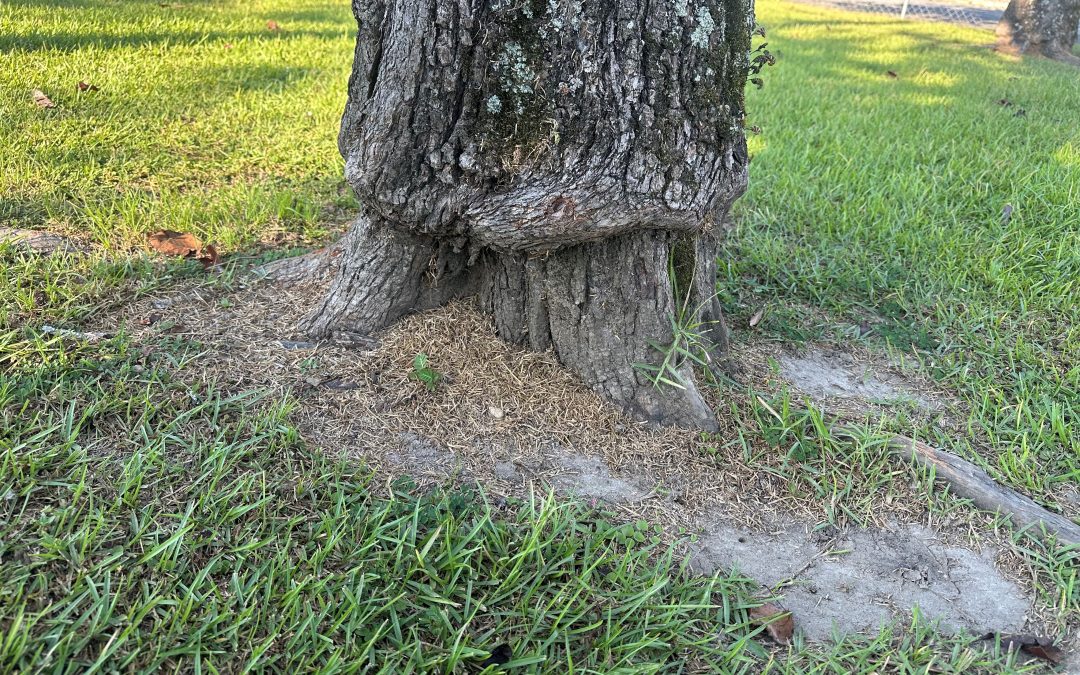
by Ben Hoffner | Sep 11, 2025
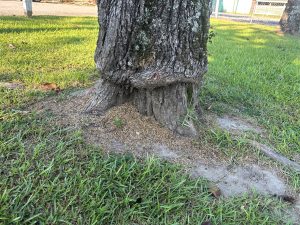
Photo credit to Daniel Leonard, Calhoun County Extension Agent
When maintaining proper care of your trees and shrubs in your lawn or landscape it is important to not damage stems and trunks. It is best practices to keep the area around the tree clean, but it needs to be done properly. Mowing and weed eating is not recommended due to the possibly of severe damage to the trunk and stems. Repeated damage from mowers and weed eaters cause damage called girdling. There are a few very effective ways to protect the trunk and stems from damage such as mulching and using tree rings/tubes.
Repeated damage to the base of the tree and stems will affect the cambium layer. The cambium layer is a thin layer of living tissue directly under the bark of the tree, and it supports the growth and well-being of the tree, actively dividing cells located between the xylem (wood) and phloem(bark). Constant damage of this layer will cut off the flow of carbohydrates to the roots, which will cause the tree to die. This layer is the green material you see after the bark of the tree has been damaged. It is imperative to keep the cambium layer damage free to insure the best tree health.
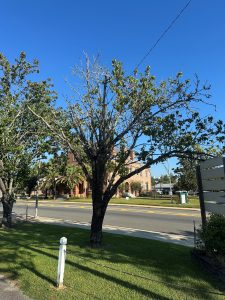
Photo credit to Daniel Leonard, Calhoun County Extension Agent
Taking preventive measures will ensure the prolonged life of your tree. Using mulch around the perimeter of the tree for protection from injury is the most effective method of protection. There are different mulch types like straw, bark, leaves, needles, wood or grass. These are examples of organic mulches. Tree rings and tubes can be helpful to protect young trees. If mulch is not the best option for the plant, other materials such as cut sections of plastic pipe or rubber tires could be an option for protection.
Mulch is not only a great way to protect your trees from injury. It also helps with retaining moisture, erosion control, weed suppression, organic accumulation and aesthetic appeal. Following simple guidelines when using mulch will make sure that you are maximizing the material used. Maintain a 2-to 3-inch layer around your established trees. Avoid “volcano mulching”. “Volcano mulching” is when mulch is piled against the base of the tree, it holds moisture. High amounts of moisture can cause the trunk to rot.
To prolong the life of your trees and shrubs you must protect them from injury that can cause girdling. Avoid constant contact with lawn mowers and weed eaters that will destroy the cambium layer. Using mulch is a very effective way for protection as well as retaining moisture, erosion control, weed suppression, organic accumulation, and aesthetic appeal.
For more information contact your local UF/IFAS Extension Office.
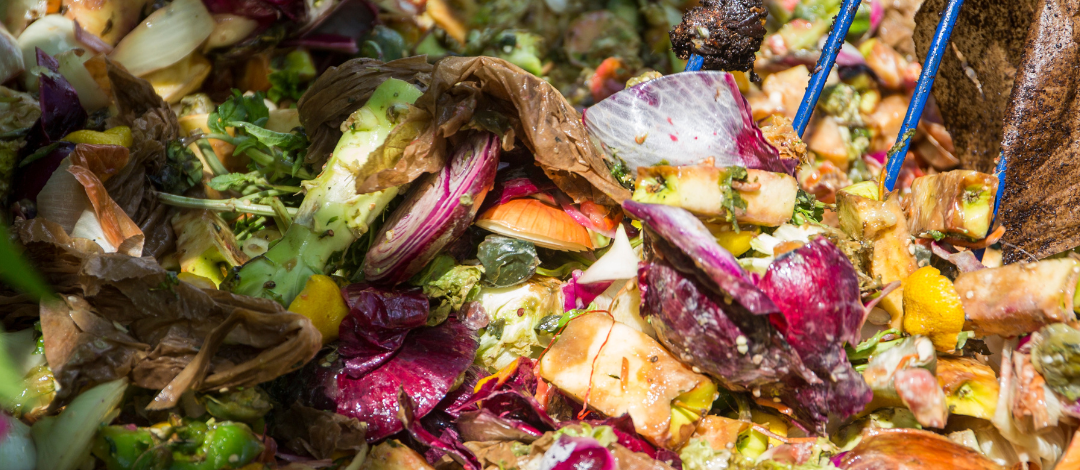
by Abbey Smith | Sep 4, 2025
As we transition from the dog days of summer into (hopefully) the cool weather of fall, it is a great time to consider the nutrient levels of your garden soil. One of the best things you can give your garden is the foundation of healthy soil, but to do that you may have to add some things over time. A natural way to boost your garden’s nutrient levels is through composting. But what exactly is compost and where can you get it?
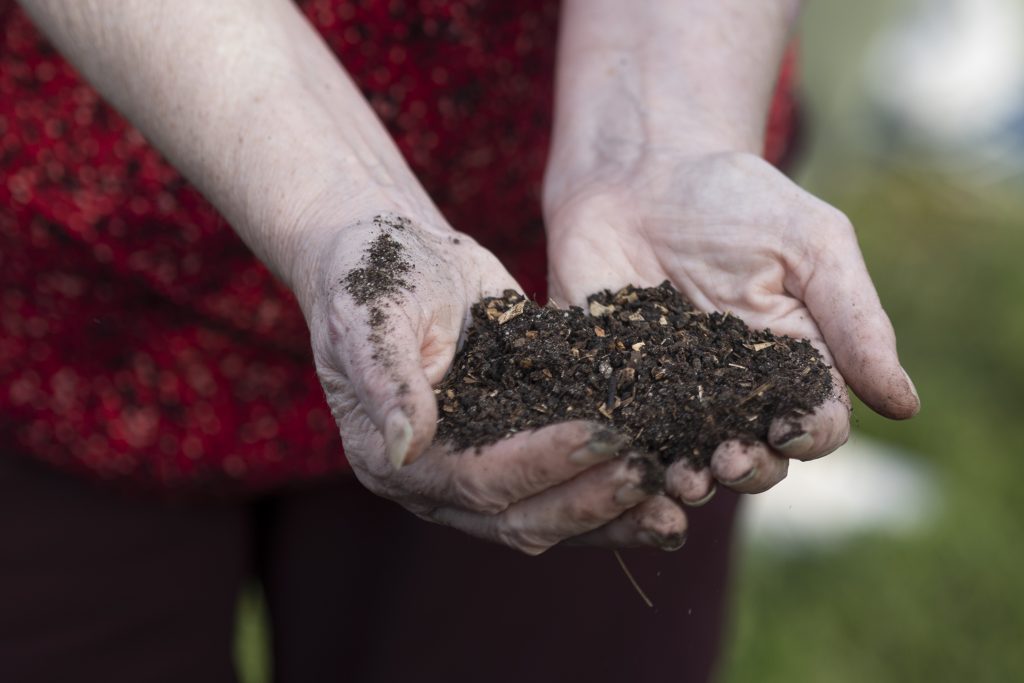
Handful of finished compost soil. Photo Credit: UF/IFAS Tyler Jones
Compost is often referred to as “black gold” by gardeners because of its nutrient dense consistency. And even better, you can make your own compost from home. Compost is the makeup of an even ratio of carbon and nitrogen by-products that naturally decompose over time to create a brown-soil like substance. Carbon products are often referred to as “browns” and nitrogen products “greens.” Examples of browns are straw, cardboard, and old leaves. Green materials are often food scraps, lawn clippings, and animal manures. Compost can be added and tilled into your garden or depending on the type of compost, it can also be used as a potting soil alternative.
It is easy to create a compost bin at home. It does not have to be fancy or expensive to create. Some people opt for a pre-made compost tumbler bin to make turning their pile easier, while others use old wood pallets for their siding. You can even create a vermicompost bin inside a storage tote and use worms to do the composting for you. There are many possibilities. But it is important to note that bins do create a slight odor, because they are breaking down waste products. Location of your bin should be kept in mind if you don’t want close neighbors or even family members making complaints about the smell. However, if there is a strong odor overtaking, it could indicate an issue with the bin and will need to be addressed. Keeping a 1:25 ratio of greens to browns will keep odors at a minimum.
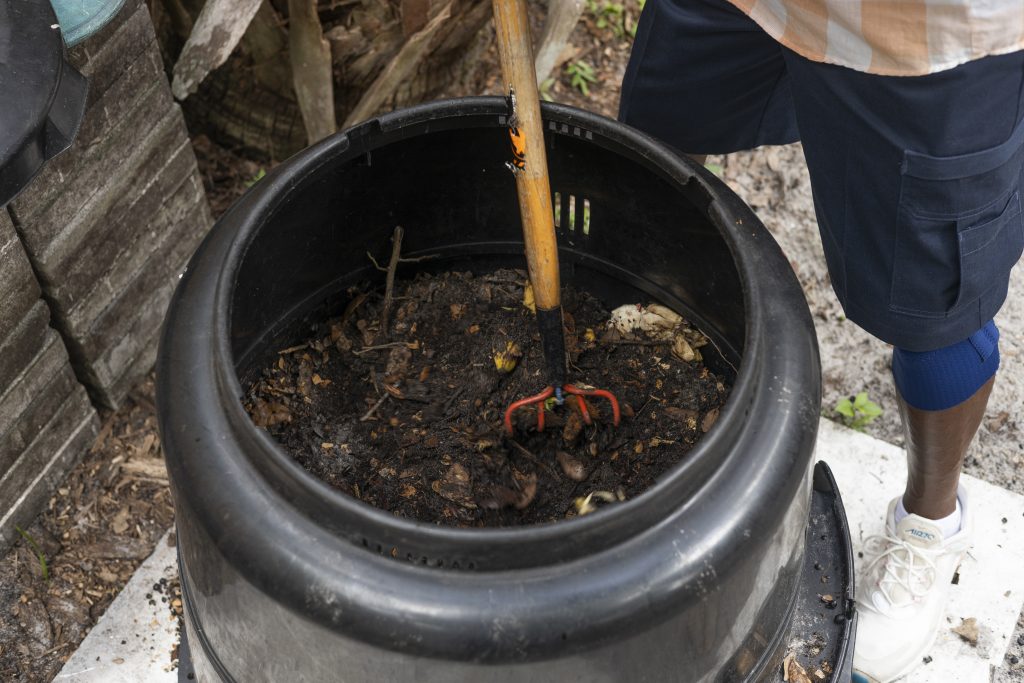
A compost bin being stirred. Photo Credit: UF/IFAS Cat Wofford
If you are interested in hearing more about compost and getting a hands-on demonstration on how to build a compost bin at home, the Jackson County Master Gardener Volunteers are hosting an informational workshop called Backyard Composting 101 on September 20 at 9:00 am at the Jackson County Extension Office. Admission is $7 per person. Space is limited for this class, so be sure to call 850-482-9620 to pre-register today.
For more information, please visit:
https://gardeningsolutions.ifas.ufl.edu/care/fertilizer/compost/
https://sfyl.ifas.ufl.edu/sarasota/natural-resources/waste-reduction/composting/what-is-composting/methods/
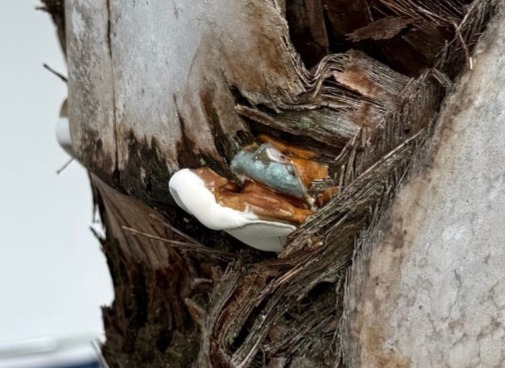
by Evan Anderson | Sep 4, 2025
No plant is as closely associated with Florida as a palm tree – the native sabal palmetto is the state tree, in fact! While this and several other species of palm are hardy even into the cooler regions of the panhandle, there are occasionally problems that arise with them. Palms tend to be sturdy in the wind, handle salt spray, and deal with drought without much issue. A few diseases can strike them, however, and the fungal pathogen Ganoderma zonatum is one of them.
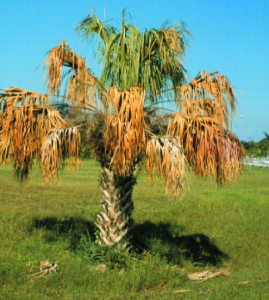
Symptoms of a tree infected with Ganoderma butt rot. Image credit: M.L. Elliott
Ganoderma butt rot, caused by this pathogen, can affect any palm tree no matter the species. It only attacks palms, so nearby hardwoods or conifers are safe from it. As a fungal disease, it spreads by spores, which are produced on a conk (a type of mushroom that is wide and flat, usually growing on decaying wood). By the time the conk is visible on the trunk of a palm, the damage is done. The fungus slowly rots away the lower four to five feet of the trunk, working invisibly until it is ready to reproduce. The trunk of the palm will not become soft or spongy as the disease develops. There may be other outward symptoms of the disease, including slower growth, off-color foliage, and wilting and dying of fronds starting from the older bottom fronds. These symptoms occur with other diseases and problems as well, making it difficult to diagnose Ganoderma butt rot until the conk is visible.
A conk will start out as a small, white, button-like growth on the trunk. As it grows, it expands, flattens out, and develops a brown or reddish-brown coating on top. Old conks turn fully brown. It is uncertain how long it takes a newly infected palm to develop conks; it may be months or even years.
Once a tree is infected with this fungus, there is no cure. Removal of the tree is the only option, and as much of the trunk, stump, and roots as possible should be taken out. Conks may form on stumps after the palm is cut down, which can help to spread the disease. The fungus, unfortunately, persists in the soil even after the palm is removed, so infected palms should be replaced with other types of plants.
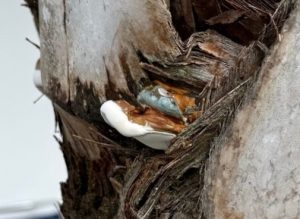
A small, relatively newly formed conk.
Frustratingly, the disease is difficult to predict. There do not seem to be any conditions that favor the disease in particular – it has been observed on otherwise healthy plants as well as stressed ones, and on naturally growing palms as well as those that have been transplanted. Still, keeping plants of any sort as healthy as possible can help them to resist pests and diseases, so fertilize, irrigate, and prune palms properly.
Evan Anderson
Walton County Horticulture Agent
by Danielle S. Williams | Aug 28, 2025
Persimmons are an increasingly popular fruit crop in North Florida that are prized for their rich flavor, vibrant color, and adaptability to the state’s climate. With varieties ranging from astringent to non-astringent, persimmons offer growers and consumers a diverse and delicious harvest. Persimmons thrive in well-drained soils and require minimal pest management, making them an attractive crop for both commercial and backyard growers.
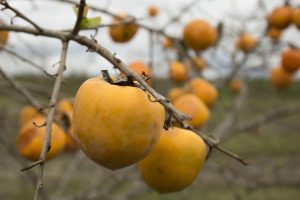
Persimmons. Photo by Tyler Jones, UF IFAS
To help growers, home gardeners, landowners, and enthusiasts learn more about persimmons, UF/IFAS Extension is hosting the 2025 Persimmon Field Day on Thursday, October 23rd from 8:45AM to 11:30AM EST at the UF/IFAS North Florida Research and Education Center (NFREC), located at 155 Research Road, Quincy, FL.
Attendees will:
- Tour the NFREC’s persimmon grove to learn about tree care, maintenance, and harvesting techniques
- Sample a variety of persimmon cultivars
- Connect with experts and fellow growers
Light refreshments will be provided. Space is limited, so please register using the link below to reserve your spot!
For more information, please contact Muhammad Shahid at 850-875-7150 or via e-mail at mshahid@ufl.edu
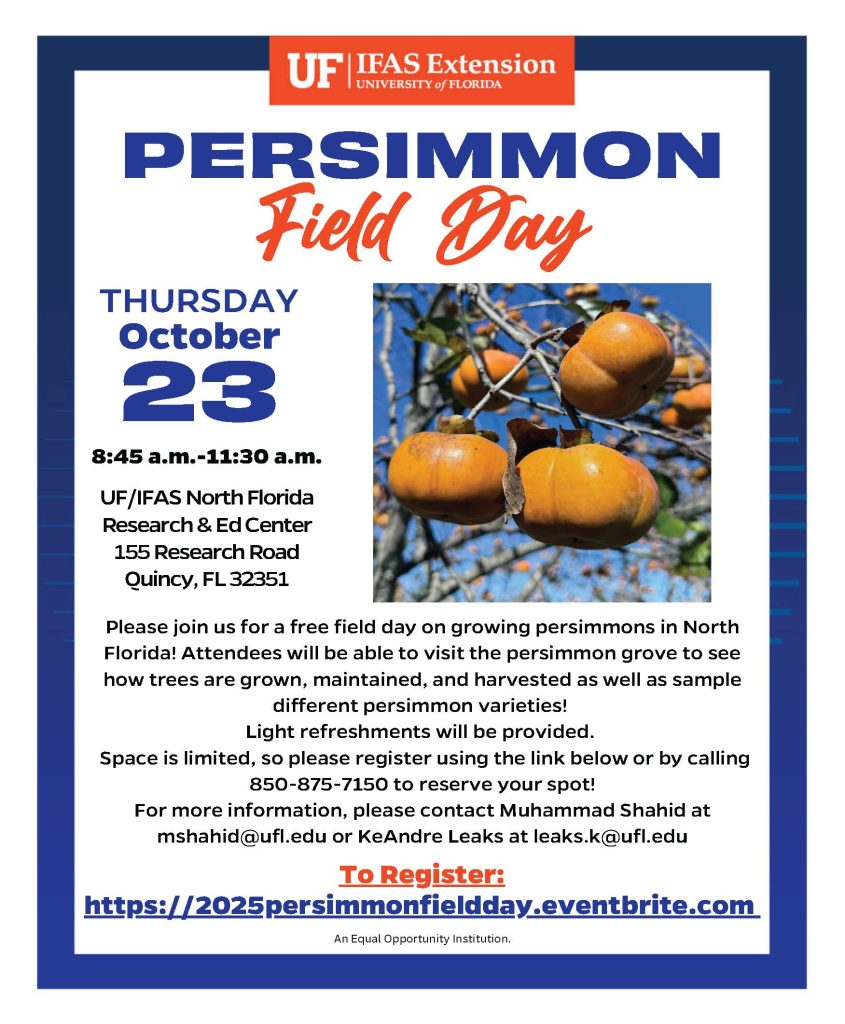
The University of Florida is committed to providing universal access to all our events. For disability accommodations such as sign language interpreters and listening devices, please contact Muhammad Shahid, (mshahid@ufl.edu, 850-875-7255) at least 2 weeks in advance. Advance notice is necessary to arrange for some accessibility needs.
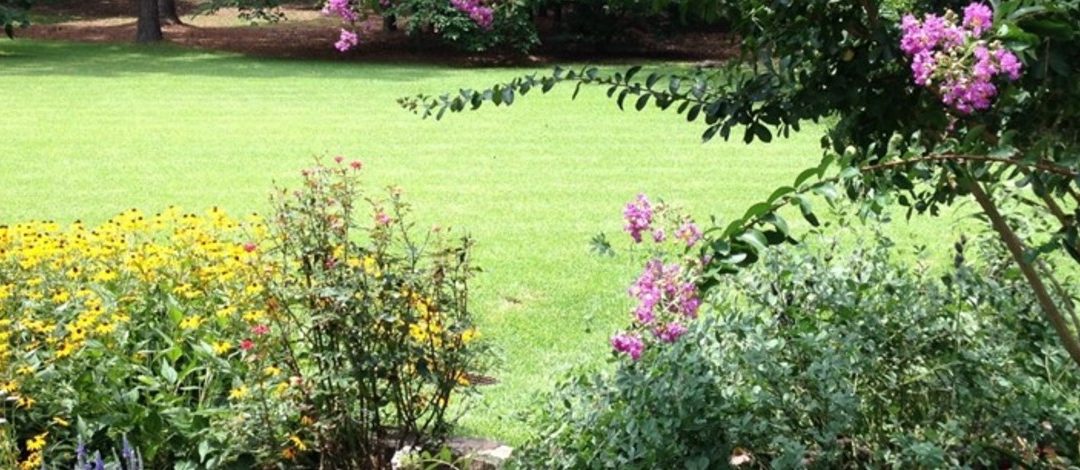
by Larry Williams | Aug 23, 2025
Hot, summer months are not the time to be using most lawn herbicides.
One issue is the heat of summer. Most lawn herbicide labels include statements such as the following. “Do not apply when temperature exceeds 90°F.” “Do not broadcast apply this product when air temperatures are above 90°F (85°F for St. Augustinegrass) unless temporary turf injury can be tolerated.”
Every year lawns are injured or killed because of lawn herbicides being applied when temperatures are too hot.
Summer is usually a rainy and windy time of the year. Many lawn herbicide labels include statements such as the following. “Allow 12 hours after application before watering lawn for maximum effectives on listed weeds.” “Apply only when wind is no more than 10 mph.” “Applying this product in calm weather when rain is not predicted for the next 24 hours will help to ensure that wind or rain does not blow or wash pesticide off the treatment area.”
It is critical to read and follow the label directions and precautions for any pesticide you use. Pesticide labels, including herbicides, include the following statements. “To the extent consistent with applicable law, the buyer assumes all risks of use, storage or handling of this product not in accordance with label directions.” “It is a violation of Federal law to use this product in a manner inconsistent with its labeling.”
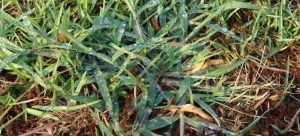
Crabgrass growing in centipedegrass lawn. Photo credit: UF/IFAS Extension
By the time summer arrives, many of the lawn weeds are mature, which means they are well established with extensive root systems. These mature, well-established weeds are more difficult to control. The same weeds are more susceptible to herbicides when they are small, young and not well established. Also, these mature weeds have produced countless numbers of seeds by summer. Most weeds are prolific seed producers.
A single crabgrass plant (a common summer lawn weed) can produce 150,000 seeds!
Applying a preemergence lawn herbicide in February to help prevent summer annual weeds such as crabgrass or applying a postemergence lawn herbicide during spring while the temperature is mild and before the weeds are out of control simply makes more sense than waiting until summer.
The best options now with lawn weed control involve continuing to follow good mowing practices, maybe hand removal of some weeds and just simply waiting for next February and spring to use lawn herbicides.
In the meantime, you may want to read the following UF/IFAS Extension publication on lawn weed control. https://edis.ifas.ufl.edu/pdf/EP/EP14100.pdf













